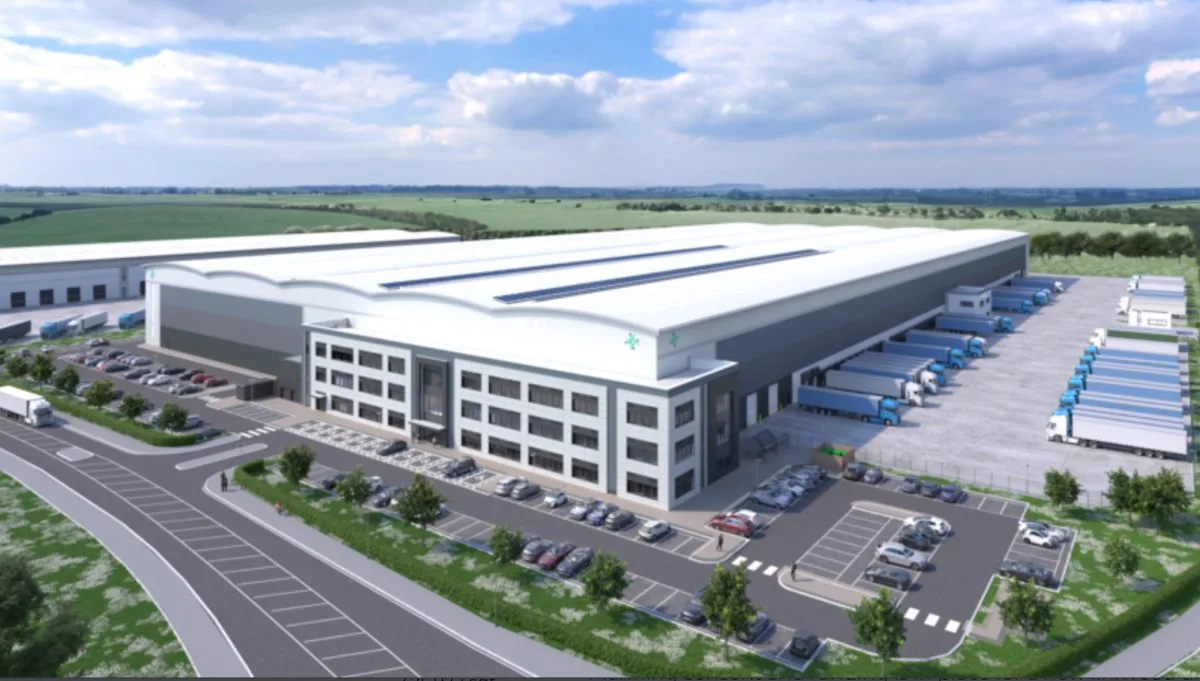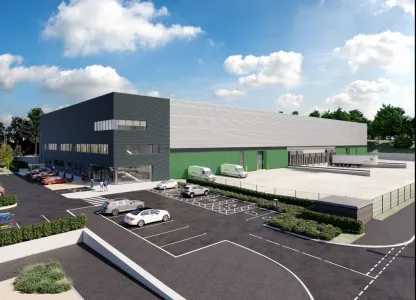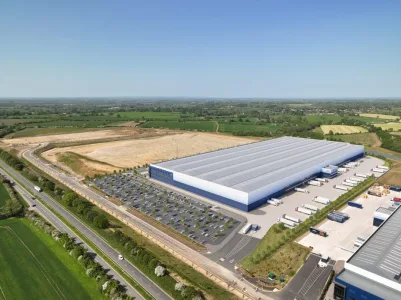Sunshine and showers…
Occupiers are back, and developers and investors are breathing a sigh of relief – for right now overall supply is at a decades level high but the benefits to occupiers look to be short-lived as the future development pipeline has fallen off a cliff and shortages are already being predicted. Just what is going on asks Liza Helps.

By Liza Helps, Property Editor, Logistics Matters
IN THE latest Future Space report Tritax Big Box and Savills say that occupier sentiment is positive with 94% of occupiers who replied saying they need the same or more warehouse space in the next two years. Occupiers made up 125 out of a total of 330 respondents to the survey.
Savills head of EMEA industrial and logistics research, Kevin Mofid says that the company’s in-house requirement index saw an 11% increase across the board in the final quarter of 2024. “There are more requirements in the market now than in the Autumn post budget and if we tag this to take-up data lagged by three quarters to reflect the time taken to complete a deal, there is potentially enough demand in the market for take-up to hit 17-18 million ft2 in the first half of the year – exceeding first half year take-up in 2023 and 2024.”
Anecdotally, Cain International’s managing director Jon Strang notes: “Demand is unlocking, we have had more enquiries, more site visits and rental offers [across our buildings] in the last two months than in the whole of last year.”
For developers and landlords this has come as welcome relief. During the pandemic take-up of warehouses over 100,00 ft2 in the UK boomed to 55.1 million ft2 in 2021 a peak fuelled by a massive shift in online shopping which soared from a base of 19% of overall retail spend almost doubling in the space of a year to peak at 36% before settling to around 26.9% at the turn of 2025 according to Office of National Statistics figures.

Take up levels remained high through 2022 with half year take-up reaching a new record of 28.6 million sq ft surpassing the previous years half year total and exceeding the H1 average by 90% despite inflationary pressures and fall in consumer confidence following geo-political upsets with Russia invading Ukraine.
“Everything changed when the Truss mini budget happened [in September 2022],” says Maple Grove Developments director James Scott. “there was an immediate value drop and investors froze funds and lost confidence, gilt rates went up making funds question the point of holding property and the cost of living spiralled.”
The result was an almost overnight stop not just in new property investment but also take-up – occupiers fell away pausing deal making and in some cases pulling out of deals altogether – take-up for 2023 dropped 40% to 29.1m sq ft.
“The issue,” according to Strang, “was that developers and investors were committed to building space as if take-up was going to continue at levels of 40 million ft2 plus a year. Landlords started to experience extended void periods that were longer than liked.”
And supply started to increase with vacancy rates getting higher. According to Lambert Smith Hampton’s Industrial and Logistics Market Report UK-wide supply increased for a third successive year to reach 84.2 million sq ft at the end of 2024, a rise of 15% year-on-year. The majority of that supply is dominated by grade A space, reflecting a surge of speculative development that came in the wake of the pandemic.

Research from real estate analyst CoStar points to a bit of a building glut in the last five years with some 120 units built or under construction between 100,000 ft2 and 249,000 ft2 currently available nationwide with a further 52 units (37 existing and 15 under construction) between 250,000 and 499,000 ft2 available, and six units ( two existing and four under construction) over 500,000 ft2.
Against this backdrop it is hardly any surprise that speculative development has dried up with Strang saying: “The case for speculative development is challenging right now.”
Real estate analyst CoStar’s director of market analytics Grant Lonsdale says: “There are very few speculative developments breaking ground with 2025 being the weakest year for construction starts in a decade across all size ranges.”
Indeed, Colliers’ head of industrial and logistics research Andrea Ferranti says: “We have long observed that there would be a slowdown in speculative development as a result of market conditions. High borrowing costs for developers have kept a lid on land values and while recent Bank of England rate cuts signal a potential turning point, current financial market expectations of higher inflation and subdued GDP growth are driving bond yields upward, tempering optimism and slowing the pace of recovery.”

Cole Waterhouse development manager Rob Titterdon agrees: “The reason why there is so little development both speculative and build-to-suit is due to inflation and the cost of borrowing – what is the point of building speculatively even if you can get the funding if the property is going to just sit there costing money – it is expensive to borrow.”
Scott adds: “It is difficult to stack up appraisals not least because post the mini budget inflation soared: build costs are 40-50% higher and there is still inflation although at only 2-3%. It is difficult to be competitive when costs have gone up so much.”
FI Real Estate Management director and founder Tim Knowles says: “There are lots of issues affecting why a developer can or cannot build viability, planning and supply and demand are the main issues we encounter. If a developer doesn’t have their own construction business in-house, they can quickly lose control of costs.”
In addition, notes CBRE’s Executive Director and Head of Logistics Capital Markets Jack Farmer: “Investor focus is looking at capital core plus and value add.”
Backing
In layman’s terms that means those that provide the financial backing for industrial and logistics space fell they can get better returns looking at alternatives to straight forward speculative or build-to-suit development.
A lot of investors are looking at securing existing space where it can be asset managed possibly through refurbishment and re-let at higher market rents, then traded or else securing under rented properties – termed revisionary – asset managed and securing higher rents at rent review or lease renewal.
Recently investor Kuwait Financial Centre (Markaz) formed a joint venture with Delin Properties to refurbish warehouses in the UK to do just that. It has invested £27 million in the acquisition and future refurbishment of a 197,276 ft2 facility on the Colebrook Industrial Estate in Tunbridge Wells, Kent to provide a Grade A facility.
Delin Property’s Head of Investments Raffi Killian, said: “We’re taking a dated asset with low site density in a great location that needs hands-on asset management to meet today’s occupier needs.”
Farmer says: “With a focus on core plus or value add, securing deals particularly build-to-suit deals is challenging. The bids are not going to be appetising to developers or occupiers. There has been less than a handful of build-to-suit deals since 2022 and those that do secure funding are usually backed by REITs that can deliver because they do not have to finance their deals [through the market].
Inflation
Savills Industrial & Logistics Occupier Advisory Director Tom Shaw says: “The market is very fickle due to the cost of debt and the trajectory of inflation. As a result, only a very small pool of investors can finance build-to-suit. It favours cash rich or balance sheet developers.
“Similarly speculative development at present also favours balance sheet rather than those requiring third party funding.”
It is no wonder then says Ferranti that “speculative development halved in 2024 to around 9 million ft2 and currently we are tracking some 10.2 million ft2 of speculative space under construction which would pretty much be the whole balance for delivery 2025 – and a few of these units may not actually complete until 2026 due to construction delays.
“It seems that there won’t be much more space coming forward through 2026 as there has not been a lot of new announcements and many key players have units in the market which they will want to get rid of before they commit to new speculative development.”
What does that mean for occupiers? Simply put it is expected that the elevated levels of supply will diminish markedly over the next 12-18 months with a result that occupiers will find it difficult to secure the space they require until speculative development picks up. Already there are pockets of undersupply especially for the larger units nationwide where CBRE’s Industrial & Logistics Executive Director and Head of A&T Occupier Services, Jonathan Priestley says: “There are some big requirements.”
But all is not lost – those developers that have already secured funding or can build off balance sheet are poised to hit the button with many sites progressing as ‘oven ready’.
Hybrid planning
Typically, sites are being brought forward with hybrid planning applications with detailed planning for infrastructure and utilities work in place from day one and only reserved matters planning required for the actual facilities construction being presented once a tenant signs up – in effect de-risking the project from both a developer/landlord and occupier perspective. Capital is not tied up in a building waiting to be let but deliverability is still guaranteed for the occupier once a deal is signed.
This is certainly the route down which Maple Grove is going with its 1.7 million ft2 Lancaster Central Scheme in the Northwest. The site could accommodate a 600,000 ft2 cross dock facility.
Priestly says: “We are at a point where developers and investors will look at the next phase of speculative development to meet market requirements that will kick on through into the end of this year and through to 2027.”
Farmer notes that interest in speculative development from investors is back on the agenda as a way to secure better quality space particularly in core locations, but investors are conscious of timing. “They may secure a site or redevelopment opportunity but may not look to build out for 18 months to two years while they wait for a lease to expire using the time to secure planning permissions – they know that the supply demand environment Is not quite there just yet.”
Speculative development
Where there are well established shortages – especially for those 500,000 ft2 plus requirements developers that can, are pushing forward with speculative development. Panattoni is currently under construction with its 770,000 ft2 Park Central (A1M) scheme in Yorkshire – the largest single speculative build unit hitting the UK market in 2025 while GLP is progressing with its 761,361 ft2 MPN 761, speculative unit in Magna Park North Lutterworth. Construction is expected to be completed in June 2025. Other units over 500,000 ft2 include Logicor’s Derby 507 a new 507,503 sq ft logistics / manufacturing warehouse facility, with 18m eaves height, under construction and available in Q1 2025 while Mirastar’s Xdoc 549 scheme in Widnes which totals 549,665 ft2 is expected to reach practical completion in April.
A further look at Future Spaces
In the latest Future Space report published Tritax and Savills effectively asked occupiers what were their biggest issues were, and that question (among many others) garnered multiple answers but chief among them were the rising costs of labour and energy.
The changes announced by the Government to National Insurance in the Autumn budget which are due to come into effect in April this year sees the logistics sector looking at an additional national insurance bill of £1.7 billion and that coupled with the 6.7% increase in the costs of minimum wage has seen employment costs soar.
Most of the costs increases will be passed on, but some will be absorbed through cost cutting and efficiencies. In a similar way the ever increasing energy prices are passed on in the main but where contracts are squeezed or there is just no way to keep raising prices and still remain competitive those companies need to find efficiencies.
It does seem that occupiers are embattled particularly 3PLs – its a confluence of a myriad of hits over and above the rising employment costs and rising energy costs. There are rate hikes down the line and rent levels have soared over the past five years – reading recent developer and REIT annual reports indicate by just how much. Whether an occupier is seeking a new facility or whether they face a rent review this year, the rent hike could be unpleasant compared to five years ago (the typical length between rent reviews).
London Metric property reported lettings and regears on 12 urban logistics warehouses added £1.9 million of rent per annum, reflecting an average uplift of 39% against previous passing rent and that is not unusual across the board be it big box or urban facility. In its latest annual report to 31 December 2024 Tritax reported a 34.6% increase in aggregate across open market linked rent reviews settled in 2024 while SEGRO saw a 43% rise in rents at review and renewal over the same period.
At the same time storage rates for customers dropped. There was a massive increase in the amount of space taken up by retailers, ecommerce companies and 3PLs driven by the boom in online shopping during the pandemic. Post-normalisation of these markets has meant that many 3PLs whose contracts with ecommerce companies have finished or are due to finish find themselves in a position with empty racking – a surplus of grey [pallet] space but because they are tied into leases of at least five years they have not been able to divest themselves of the liability.
Five year break
With many leases taken on five year terms and others with five year break clauses occupiers are in the position to put right that issue. And indeed, some have already done so consolidating and moving into higher grade facilities as evidenced by the increased take up of Grade A facilities during 2024 and the delivery of secondhand space back to the market.
Occupiers, when they do make the decision to move now, are not just taking space for business expansion. They are looking to solve their chief issues as well.
According to the Future Space report while business growth (63%) is the most commonly cited reason for taking new space, occupiers typically cite two or three other reasons as well, including expansion to new sectors, network realignment, footprint consolidation, increasing automation, holding more stock, improving ESG and power security. More than a third (36%) cite this as a barrier to securing future space compared to 11% who did so in 2023 and 7% in 2022. Power security is a growing concern.
It is no wonder then that those developers and investors providing speculative space are looking to provide best-in-class facilities. There is a correlation between the highest rated building and the benefits they can provide occupiers in terms of operational costs savings first and foremost.
Secondary benefits include the fact that the majorly of best-in-class facilities pay close attention to amenity provision and landscaping – the soft power attributes that assist in attracting and retaining staff.
Baytree development manager Casey Ferguson says: “There is a flight to quality, and we need to be the best in the market.”
The developer has just reached practical completion on its BREEAM Outstanding scheme in Leeds – the first such highly rated speculative development in the region. The scheme provides two units of 76,231 and 145,454 ft2.
“We are looking for a top rent but not significantly ahead of the competition in doing so we have to justify that rent the onus is on us to show how much an occupier can save by taking our property.”
The developer provides PV solar array on the facilities which can save occupiers up to 50% on annual electric usage. “In monetary terms that £38,000 for Unit 1,” says Casey.
There is almost a arms race between developers to provide best-in-class scheme not only to differentiate but also to provide investors with a future proof asset.



